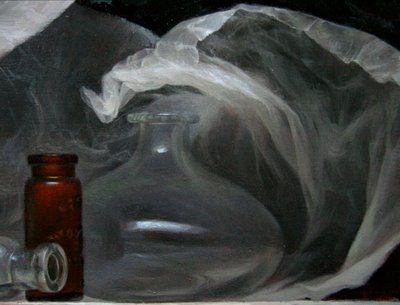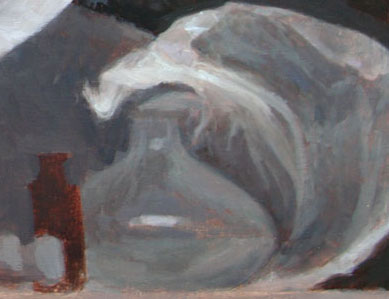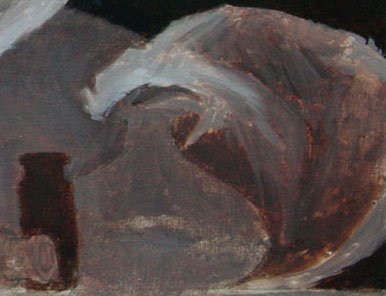Bottle Collection: Overpainting
 Sunday, April 12, 2009 at 11:54PM
Sunday, April 12, 2009 at 11:54PM Finally getting to a high level of finish in one corner of the painting. Here are the previous stages of this area (it's about a 5 x 6 inch corner of a larger 18 x 24 inch painting):
I was taught to paint first the background, second the ground plane, third the shadow side of objects, and finally the light side, in that order. But I find that tackling a painting is sort of a psychological game, and I get bored and frustrated working on the background and ground plane for days before I get to the "good parts".
So I've developed my own method. I have found that I need to bring an exciting/challenging area up to the highest finish I can. That sort of sets the standard for the rest of the painting, and I have to bring everything else up to the same standard. It keeps me excited to work every day and makes it all seem like a fun challenge, and less like an impossible acreage to cover with my tiny brush.
I think every painter must have to develop their own way to approach a painting to stay engaged and motivated, and to avoid over thinking, or avoid just giving up out of frustration or intimidation. It's a psychological dilemma to solve every day in the studio.
I'd love to hear how you solve this. Or, if you are not a painter, how you keep yourself energized and excited for any challenging project? Do you do the fun parts first and crank out the boring bits at the end? Or do you save the best for last? Do you tackle the hardest things right away, or warm up with more manageable steps?



Reader Comments (8)
Mixing music might be similar. I start with a rough balance of levels on everything ( drums, bass, guitar, piano, voice, etc.), which is like getting your background or foundation. In this first stage I also try to establish the panning of everything. Each instrument needs to be located in space well with each other to give the image of your mix. Then I spend time EQ'ing individual instruments and start adding reverb. While I'm doing this though I am often going back to stage one and tweaking my rough mix. At this point I have established a mix which is well balanced, EQ'ed, panned, reverbed. This picture or mix is looking like your second or third stage. Finally I turn on my computers automation and write level rides on the mix which ultimetly brings out all the detail and life to the mix. This is the technique I was taught, but I often jump around between stages. This is mostly because a change of one thing can change the relationships between everything else.
I too agree that with every technical art form you have to have a process which works for you. I could see how cooking could be simalar to painting as well.
the painting is going great! another masterpiece in the making. Your comments on approaching painting came as fresh air as i have struggled for two hours with a lemon! tried everything i could think of to get the effect i wanted and finally frustrated i left it because i could no longer see! i would not share what i do to start a painting as it is chaotic but one thing i do is to practice on old canvas a particular subject with a variety of colours before working on the underpainting. and like you i do like to get the main subject as right as possible before i give it some background just to seee how it will react in that environment. and of course i need good music:)
Hi Sadie,
The way i like to work is quite methodical for me.
First i find inspiration from othyer artists working in a sililar vein.
Then i draw the outline with a diluted mix of colour, using sight size to correct any mistakes.
Then i start laying in all the correct values and working the entire canvas at the same time.
This i find helps me stay excited about the end result, also not being afraid to loose the image is all part of my growth as an artist.Keep up the great work, it sure looks fantastic. Dee
I find it helps to work on more than one project at a time. If I get excited and absorbed in one, great. If I hit a wall, I work on something else for a bit.
I also find that different tasks lend themselves to different energy levels and states of focus. If I am tired, or working in the evening, when my energy is at its lowest, I do stuff that ordinarily would be monotonous but at that time is actually pleasant to do. Again, having more than one project helps so I can pick what matches my energy level best at any time.
I also tailor my audio to what I am doing. If it's boring, I stick on an audiobook or a brainy radio program. If it's something tricky and I need to focus, I choose something more of an audio wallpaper.
Very interesting post! I know that I use my own methods that don't follow along with a lot of what I was taught in school, but I have found that what works for me is what works, and I'm learning to tune out the "you have to do it this way" rules. I don't hold my charcoal the right way, I don't measure the right way, I don't stand at the easel the right way, etc.
I usually do some type of underpainting, but lately I've experimented with bringing small parts of my work to more of a finish before continuing on (working from top to bottom). This is very different for me, but I find it refreshing and I like the results I'm getting.
I also like to work on more than one thing at once, though sometimes space keeps me from doing that.
I need to have an underpainting, somwhat linear, somewhat masses of value with my darks pretty dark but transparent. I tend to paint a preliminary background in the approximate value range and color I want to that I can work the subject matter in relation to that background. Then I generally work to a pretty high degree of finish on parts of the painting, going from one to another if I get bored. (I tend to get caught up in the details and love painting them.)
I also have several paintings going at the same time; my mood seems to dictate which one gets my attention unless, of course, I am down to the wire on a deadline (portrait commissions, usually.)
I am self-taught; in recent years I have taken several workshops, but I find that I still work the way I found best for me through years of trial and error.
What an incredible series of paintings you have produced with this wax paper theme! Who knew? LOL
Wow, thank you so much everyone for posting your processes!
I think its so amazing how artists of all disciplines work.
There's the way we are taught, but each of us also has to find the way that works best for US.
David I agree cooking is similar- and gardening! I have often thought I could get obsesses with either but I save the energy for my painting.
On the other hand, my friend Shawn Kenney is both an amazing artist AND a good cook, his incredible food paintings show his love of both:
http://www.shawnkenney.com/blog/" REL="nofollow">Shawn KenneyDAVE - Nowell just told me that's YOU :) Thanks for posting your method, that's so amazing it relates so much to developing a painting, I had no idea!!
Rahina I know that feeling well! And I have a tip for getting out of it - look at the subject, NOT at your painting! Stop painting, put down your brush, and just look. Getting lost like that is forgetting to look look look. I know because I do it myself :)
Thanks everyone :)
I am glad to hear of your following your instinct, rather than always following the rules.
Being a realist means long hours of painting. I entertain myself by painting whatever "speaks" to me at that moment. I am enjoying your work and your blog.